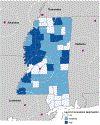Abortion at 12 or more weeks' gestation and travel for later abortion care among Mississippi residents
- PMID: 34971606
- PMCID: PMC9036644
- DOI: 10.1016/j.contraception.2021.11.003
Abortion at 12 or more weeks' gestation and travel for later abortion care among Mississippi residents
Abstract
Objective: To assess the association between indicators of economic disadvantage and geographic accessibility of reproductive health services and abortions ≥ 12 weeks' gestation in Mississippi.
Study design: This cross-sectional study used data on Mississippi residents who obtained abortion care from 12 of 14 facilities in Mississippi, Alabama, Louisiana, and Tennessee in 2018. We estimated logistic regression models to assess the association between levels of county deprivation, the number of obstetrician and/or gynecologists per 10,000 women, and one way distance to the nearest facility with having an abortion ≥ 12 weeks' gestation. We compared the median one-way distance to the facility where patients < 12 weeks', 12-15 weeks', and ≥ 16 weeks' gestation received care, using Kruskal-Wallis tests.
Results: Of the 4,455 Mississippi residents who obtained abortions, 73% were Black, 59% lived ≥ 50 miles from a facility, and 60% obtained care in Mississippi. Overall, 764 (17.2%) abortions were performed ≥ 12 weeks' gestation. In adjusted models, those in counties with moderate (OR, 1.47; 95% CI: 1.15-1.90) and high (OR: 1.36, 95% CI: 1.01-1.83) (vs low) levels of economic deprivation and counties with 0.1-1.4 (vs ≥ 2.5) obstetrician/gynecologists per 10,000 women (OR: 1.55; 95% CI: 1.06-2.27) had higher odds of obtaining an abortion ≥12 weeks' gestation. Mississippi residents who obtained abortions ≥ 16 weeks' gestation traveled a median 143 miles one way to the facility where they received care, compared to 69 miles and 60 miles traveled by those < 12 weeks' and 12-15 weeks' gestation, respectively (p < .001).
Conclusions: Many Mississippi residents obtained abortion care ≥ 12 weeks' gestation, which is related to greater economic constraints and limited geographic access to reproductive health services.
Implications: People's need for abortions ≥ 12 weeks' gestation may be higher in communities with limited access to reproductive health services and among those living in areas with greater economic disadvantage. State laws that narrow gestational limits would increase long-distance travel for later abortion care, and disproportionately affect those with fewer resources.
Keywords: Abortion; Gestational bans; Mississippi; Travel.
Copyright © 2021 Elsevier Inc. All rights reserved.
Conflict of interest statement
Conflict of Interest Statement: The authors declare that they have no conflicts of interest.
Figures


Similar articles
-
A global scoping review of the circumstances of care seeking for abortion later in pregnancy.PLOS Glob Public Health. 2024 Dec 5;4(12):e0003965. doi: 10.1371/journal.pgph.0003965. eCollection 2024. PLOS Glob Public Health. 2024. PMID: 39636911 Free PMC article.
-
Association of Travel Distance to Nearest Abortion Facility With Rates of Abortion.JAMA Netw Open. 2021 Jul 1;4(7):e2115530. doi: 10.1001/jamanetworkopen.2021.15530. JAMA Netw Open. 2021. PMID: 34228128 Free PMC article.
-
The impact of Mississippi's mandatory delay law on abortions and births.JAMA. 1997 Aug 27;278(8):653-8. JAMA. 1997. PMID: 9272897
-
Change in Second-Trimester Abortion After Implementation of a Restrictive State Law.Obstet Gynecol. 2019 Apr;133(4):771-779. doi: 10.1097/AOG.0000000000003183. Obstet Gynecol. 2019. PMID: 30870293 Free PMC article.
-
Abortion Care Beyond 13 Weeks' Gestation: A Global Perspective.Clin Obstet Gynecol. 2021 Sep 1;64(3):460-474. doi: 10.1097/GRF.0000000000000631. Clin Obstet Gynecol. 2021. PMID: 34323228 Review.
Cited by
-
Association of Texas' 2021 Ban on Abortion in Early Pregnancy With the Number of Facility-Based Abortions in Texas and Surrounding States.JAMA. 2022 Nov 22;328(20):2048-2055. doi: 10.1001/jama.2022.20423. JAMA. 2022. PMID: 36318197 Free PMC article.
-
Changes in Availability of Later Abortion Care Before and After Dobbs v. Jackson Women's Health Organization.Obstet Gynecol. 2025 Jan 1;145(1):e31-e36. doi: 10.1097/AOG.0000000000005772. Epub 2024 Oct 24. Obstet Gynecol. 2025. PMID: 39447180 Free PMC article.
-
Expanding access to safe ambulatory manual vacuum aspiration abortion up to 14+6 weeks following Argentina's legal reform: an observational study in the public health sector.Reprod Health. 2025 May 24;22(1):91. doi: 10.1186/s12978-025-02036-8. Reprod Health. 2025. PMID: 40410790 Free PMC article.
-
Self-diagnosing the end of pregnancy after medication abortion.Cult Health Sex. 2024 Mar;26(3):405-420. doi: 10.1080/13691058.2023.2212298. Epub 2023 May 22. Cult Health Sex. 2024. PMID: 37211833 Free PMC article.
-
A global scoping review of the circumstances of care seeking for abortion later in pregnancy.PLOS Glob Public Health. 2024 Dec 5;4(12):e0003965. doi: 10.1371/journal.pgph.0003965. eCollection 2024. PLOS Glob Public Health. 2024. PMID: 39636911 Free PMC article.
References
-
- Ibis Reproductive Health, Center for Reproductive Rights. Evaluating Priorities Ibis Reproductive Health; 2021. Available from: https://evaluatingpriorities.org/. Accessed 7/2/2021.
-
- Guttmacher Institute. State facts about abortion: Mississippi New York, N.Y.: Guttmacher Institute; 2021. Available from: https://www.guttmacher.org/fact-sheet/state-facts-about-abortion-mississ.... Accessed 7/2/2021.
-
- Mississippi State Department of Health. Title V Maternal and Child Health 2020 needs assessment, data brief 2, Maternal/women’s health domain Jackson, MS: Mississippi State Department of Health; 2020. Available from: https://msdh.ms.gov/msdhsite/_static/resources/12738.pdf. Accessed 5/27/2021.
-
- March of Dimes. Nowhere to go: Maternity care deserts across the U.S., 2020 report Arlington, VA: March of Dimes; 2020. Available from: https://www.marchofdimes.org/materials/2020-Maternity-Care-Report-eng.pdf. Accessed 6/26/2021.
-
- U.S. Department of Agriculture, Economic Research Service. Percent of total population in poverty, 2019 Washington, D.C.: U.S. Department of Agriculture; 2021. Available from: https://data.ers.usda.gov/reports.aspx?ID=17826#Pe16f2c0c31fd4827be37a31.... Accessed 7/2/2021

